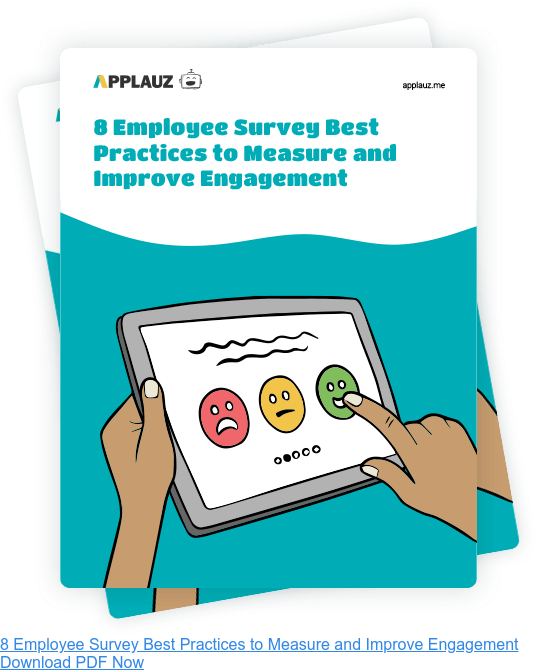Most HR professionals know the importance of collecting employee feedback. After all, you can only start fixing something if you know where the problem is. Or, more importantly, if you know something is broken in the first place.
In other words, employee surveys are an important tool in your HR toolkit.
But not all surveys are created equal. And some HR teams still make critical mistakes when surveying employees. Or they still use yearly surveys to get feedback from their workforce.
As of 2019, 74% of organizations still used large-scale surveys to gauge how employees felt about their jobs and workplace. That was a drop from 89% in 2015.
The trend is clear: many companies are moving away from traditional yearly surveys. Still, more than half of companies are choosing to stick with the status quo.
Do we need to change?
We understand why some companies choose to stick with what's familiar. Change can be -- well, stressful. As such, there could be several questions fueling this hesitation, such as:
- Our company has always done surveys this way, so why change?
- Is the way we're doing surveys now all that bad?
- Will the new survey system be better?
- What costs will be associated with changing things?
The bigger your company is, the more magnified these questions and concerns become.
Whether your company decides to change or not, one thing you can't ignore is the climate that surrounds work; it's always evolving. The past year was no exception.
Your business might not change, but employees' needs will always be shifting
In the wake of the covid pandemic, workplace burnout is on the rise. Yet, people have more freedom -- about where and how to do work -- than ever before. As a result, knowledge workers everywhere are reconsidering their options as it relates to work.
In other words, the pandemic was the push some people needed to make a big change. And for many, a traditional career path is looking like the least appealing option.
We can find evidence of this phenomenon popping up everywhere.
The New York Times recently published a piece titled The Yolo Economy. In it, the author Kevin Roose tells of burned-out workers looking to abandon their "cushy and stable jobs" for "post-pandemic adventures."
"Several people in their late 20s and early 30s — mostly those who went to good schools, work in high-prestige industries and would never be classified as “essential workers” — told me that the pandemic had destroyed their faith in the traditional white-collar career path."
It's not just editorials that are anecdotally forecasting a massive shift in the world of work. A recent Mckinsey report showed that one in three mothers have considered leaving the workforce or downshifting their careers because of the strain caused by the pandemic.
This shift in employee mentality will have major implications for businesses.
If companies wish to retain their workers, they need to start listening closely to employee needs. In short, the employee voice should be at the forefront. If your company wants to make employee engagement a strategic priority, this goal should apply to your business even more.
To that end, surveying employees only once per year falls short in many ways. In this article, we will cover that topic and more:
- We will go over the major shortcomings of long-form surveys. And outline how Pulse Surveys presents a favoured alternative.
- We will outline the advantages and disadvantages of Pulse Surveys. Although Pulse Surveys are a preferred method of gathering data, they do have drawbacks to keep in mind.
- Lastly, we will outline the ideal combination of survey methods so that your company can effectively stay tuned in to employee needs.
Traditional Yearly Surveys Vs. Pulse Surveys
Pulse Surveys take seconds to answer, VS yearly surveys are time-consuming
There's no need to sugar coat it; no one likes to fill out a long survey. If it takes more than 10 minutes, good luck getting high participation. Blame it on the internet turning people into instant gratification machines and shortening our attention spans. The truth is it's challenging to get people to dedicate time on something that has no immediate return, even though it might benefit them in the long run.
This is why Pulse Surveys are designed to be fast and simple. Most require employees to answer only one question a day. Or a few per week, continuously. Think of it as taking your long, yearly survey and spreading it out over a year. This strategy makes filling out a survey less dull and gamifies the experience. Filling out surveys might even become a fun part of their day.
Pulse Surveys continuously collect feedback VS yearly surveys capture sentiment at one point in time
surveys capture sentiment at one point in time
Are you happy with your job, boss, or workplace 365 days of the year? Definitely not. If you're like most people, you have good and bad weeks, sometimes months. Measuring satisfaction at one point in time yields biased results. In short, you're only seeing a snapshot of employee satisfaction at one point in time.
On the flip side, Pulse Surveys are continuous. So you can be consistently aligned with how employees are feeling, almost in real-time. The benefit of this is that leaders can take steps for more in-depth check-ins and make quick and necessary adjustments to improve morale and satisfaction.
Pulse Surveys are simple to administrate VS. yearly surveys take time to create and administer
Long-form yearly surveys take a great deal of money and time to create. Not only that, administering them to your workforce is also time-consuming. In other words, the administrative work can be a burden on an already busy HR team.
Pulse Surveys, on the other hand, are run with the help of software. This means that once you set them up, the administrative work is minimal. The software takes care of all of the heavy lifting. The only thing HR is required to do is wait for the results to come rolling in. And most importantly, devise solutions and fixes to the issues identified by the survey system.
Pulse Surveys are organized by topic, unearthing pain points quickly VS yearly surveys take time to distill data to make sense of results
When companies run long-form surveys, they design the questions to evaluate employee satisfaction on various topics. As such, the raw data needs to be analyzed to understand any underlying patterns and trends. These analytical efforts take time and often the guidance of outside experts.
When it comes to Pulse Surveys, the survey questions are already organized by topic. On Applauz, for example, weekly survey questions cover a certain theme. One week the system surveys employees about their satisfaction with rewards and recognition. And another week about their satisfaction with career development opportunities. As a result, HR knows exactly which areas of the work environment are “in the red” and in need of improvement and which ones are exceeding expectations.
Overview: Benefits & Disadvantages of Pulse Surveys
Although Pulse Surveys are preferred in most work environments, they are not without their weaknesses. Here is a summary of the primary benefits and drawbacks of Pulse Surveys.
Benefits of Pulse Surveys
- Very fast and easy to answer: the obvious and number one benefit is that Pulse Surveys are very quick and even fun to answer.
- Supports continuous listening: HR gets a more precise understanding of company morale as employee satisfaction is measured continuously instead of one time during the year.
- Investigates employee issues by topic: Surveys are organized by workplace topic, for example, career development and leadership, so HR can spot pain points easily and know exactly where to put their resources and efforts.
- Lets you move quickly past the data and take action: Pulse Surveys are supported by software that automatically analyses employee responses. These reports help HR quickly spot trends and take action without spending too much time on data analysis.
- Little administrative work: Because Pulse Surveys are run with software, there is very little administrative work for HR.
Disadvantages of Pulse Surveys
- You must find an ideal cadence: Even though Pulse Surveys are very fast to fill out for employees, your company should find a survey cadence that allows enough time to take action on feedback.
- Can become fatigued: Constantly sending Pulse Surveys can result in fatigue, especially if your company is not taking action on the negative feedback.
- Don't dig into the "why": Pulse Surveys help identify where and what employees are unhappy with. But they don't assess the "why" or how to fix it. In short, more polling and surveying are needed to understand why employees are unhappy or which solutions will best address their problems.
The perfect mix: Using pulse and short-form surveys
To that end, let's say you've named employee pain points with Pulse Surveys. Now the next step is to come up with solutions to resolve these issues.
Coming up with solutions to your employee problems will require a different survey method -- either a poll or a short-form survey.
For example, imagine you discover employees are unhappy with your company's rewards and recognition offerings. Yet, you're unsure which initiative would be an appropriate solution.
In other words, you have no idea how they want to be recognized. For example, do they want gift cards or a budget for social events? Or maybe they simply want more verbal recognition from their managers!
recognition from their managers!
You won't know until you ask employees directly.
Yet, this is a critical step many HR professionals skip. Understandably, lack of time and resources is often the culprit.
But remember: if you go forward and with your best guess -- by, let's say, offering gift cards, you risk spending time and money on a solution they don't care about, and worse case, completely missing the mark.
Ideally, it would help if you took your efforts further by creating a short-form survey (with Google Form of Survey Monkey) and asking workers for their opinion directly.
Bottom line: By digging deeper with short-form surveys or polls, you will uncover solutions aligned with what your employees want. And not only rely on best guesses or assumptions.
Final Thoughts
No one can truly predict how the post-pandemic "work exodus" will unfold. Will it be as dramatic as the articles make it out to be? Probably not.
But one thing is for certain: workers will have more options than ever before.
The pandemic has created many remote jobs and completely changed the way we think about work. But most notably, in uprooting our lives, the pandemic has urged us to re-evaluate our priorities. For many, emotional wellbeing, flexibility and autonomy are at the top of the list. As such, employee expectations are high, and tolerance for outdated work practices is low.
In this climate, companies that prioritize listening and actively meeting employee needs will have a clear edge in bringing in and retaining talent.
Setting your company up for success means giving employees a clear voice with the right tools, Like Pulse Surveys. By tuning into employee sentiments, your company can prevent needless turnover. And most importantly, retain the talent your business needs to thrive during the rest of this pandemic and for years to come.
About the author
 Michelle Cadieux
Michelle Cadieux
Michelle is a content writer for Applauz. She holds a Bachelor's degree in Psychology from Concordia University, and she has been writing about work and employee happiness for over five years.





